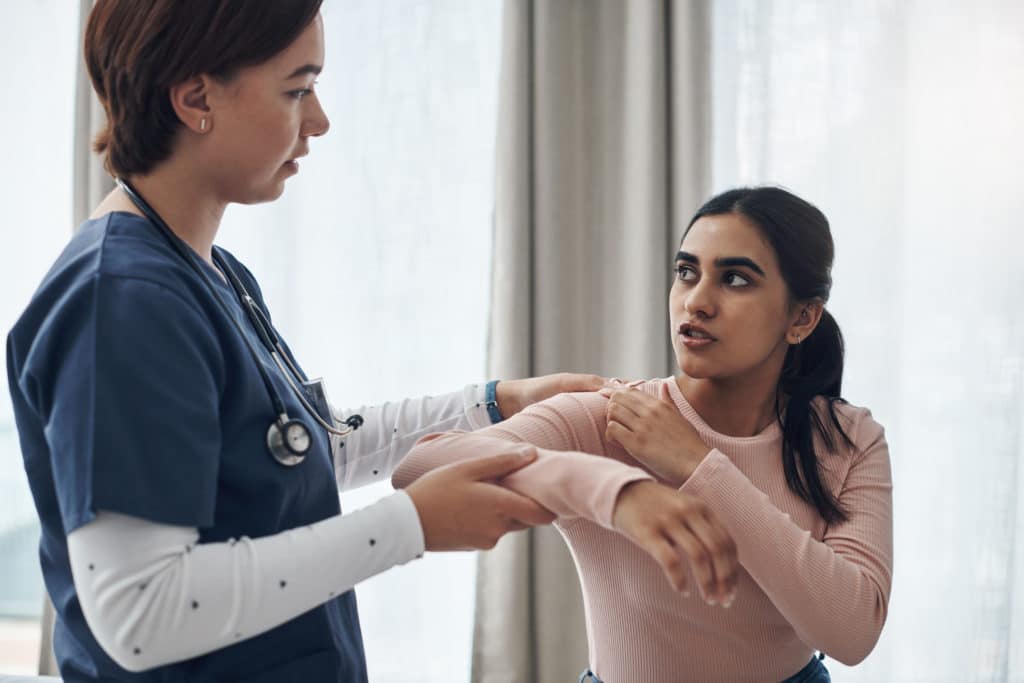

CRPS Treatment
What is graded motor imagery? How can it help people with CRPS? Find out the answers and more here.
The information presented on this page is an overview of the average evaluation of chronic regional pain treatment and is offered here as a resource. At J. Flowers Health Institute, our evaluations and treatment plans are customized and tailored to each individual’s needs. We specialize in providing a comprehensive team approach to your care. Our evaluations may include a chronic pain assessment, a medical evaluation, and a lifestyle assessment for help diagnosing your symptoms to provide the holistic care you deserve.
If you would like to learn more about J. Flowers Health Institute, please do not hesitate to reach out.
Table of Contents
Reach Out to Learn More
Complex Regional Pain Syndrome (CRPS)
Complex regional pain syndrome (CRPS) is a debilitating condition that can cause severe pain and inflammation in the arms, legs, hands, or feet. While there is no cure for CRPS, treatment options are available that can help reduce symptoms and improve quality of life. This article will explore graded motor imagery as a treatment option for CRPS and describe what to expect with this form of treatment.
What Is Graded Motor Imagery?
Graded motor imagery (GMI) is a form of treatment that can reduce pain and improve mobility throughout the body. It’s an excellent alternative treatment when traditional exercise or joint movement is too painful when treating chronic pain.1
A Closer Look at GMI
When GMI is used for rehabilitation, the focus is shifted to synaptic health and exercise. GMI is based on the principle that the human brain is adaptable and changeable.2
Why Is GMI Graded?
Depending on an individual’s functional capacity, their activity and exercises are graded accordingly. Grading allows the treatment team to ensure the intervention is manageable for the patient. Additionally, grading is necessary for functional restoration, creating a hierarchy of threatening activities, and identifying levels of fear.
What Tools Are Involved in Graded Motor Imagery for CRPS?
According to the National Institute of Neurological Disorders and Stroke, complex regional pain syndrome is “a broad term describing excessive and prolonged pain and inflammation that follows an injury to an arm or leg.”
In graded motor imagery, tools including computers, flashcards, imagined movements, education, mirror visual feedback, and computer programs are used to treat CRPS. These tools help mitigate the pain caused by CRPS, alleviating some of the more prominent symptoms.3
Flashcards
Laterality reconstruction is a practical treatment used for graded motor imagery. During laterality reconstruction treatment, imagined movements activate premotor cortices and the primary motor cortex. This therapy uses online recognition, flashcards, digital cameras, and contextualization.
Computer Program or App Called "Recognise"
Computer programs and apps, such as Recognise, can be used as convenient tools for GMI. The Recognise App is useful for left/right discrimination, explicit motor imagery, and mirror therapy. Individuals can quickly exercise their synapses from any location.4
Stages of Graded Motor Imagery
During treatments for CRPS involving GMI, left-right discrimination, mirror therapy, and motor imagery are used to promote cortical organization and activate motor networks. Throughout this process, laterality is re-established, motor imagery is performed, and mirror therapy is used.
For example, a patient imagines their hand in various positions without actual movement. Then, during mirror therapy, an illusion is created to make the brain believe the uninvolved limb is the involved limb. Therefore, the individual thinks the involved hand moves without any pain.5
Left-Right Discrimination
For laterality reconstruction, a person needs to recognize if the presented limb image is left or right-sided. People don’t know they’re moving mentally with implicit motor imagery or left-right discrimination. This left-right discrimination method is less likely to activate pain within the body. This first phase of GMI is used to re-establish an individual’s right-to-left orientation.
Explicit Motor Imagery
Individuals know they’re mentally moving during explicit motor imagery or imagined movements and activate their primary motor cells. The individual watches and imagines movements that become more complex over time. Motor imagery can be conducted with or without a mirror box.
Mirror Therapy
Mirror therapy during GMI phase three occurs when a mirror is used to display a reverse limb image to the brain. This form of motor imagery training essentially tricks the brain into thinking that the injured limb moves without pain.

How Could Graded Motor Imagery Help CRPS?
People with CRPS nerve damage can experience spontaneous pain, skin temperature or color changes, tissue wasting, stiffness in affected joints, and impaired muscle strength or tightening.
Graded motor imagery training is an effective treatment tool for individuals with a chronic CRPS diagnosis. The following section will explore how motor imagery training can help with CRPS hand therapy and complex or chronic regional pain syndrome.
Does Graded Motor Imagery (GMI) For CRPS Work?
Graded motor imagery for CRPS is the most effective treatment for individuals with chronic imagined pain syndrome, psychogenic pain, and CRPS. The National Institute of Neurological Disorders and Stroke lists the following primary therapies for CRPS: rehabilitation and physical therapy, psychotherapy, graded motor imagery, medications, spinal cord stimulation, neural stimulation, spinal fluid drug pumps, and holistic therapies.
Complications of CRPS
Complications of CRPS can include atrophy, contracture, autoimmune conditions, and more. The following sections will explore tissue wasting and muscle tightening due to CRPS.
Tissue Wasting (Atrophy)
Individuals with CRPS typically struggle with poor circulation. This side effect of CRPS can prevent proper tissue healing and deprive tissues of critical nutrients. It’s essential to perform exercises for CRPS-affected hands to avoid tissue atrophy.
Muscle Tightening (Contracture)
Poor circulation also affects muscles within the body due to a lack of nutrients and oxygen. To combat muscle tightening, individuals should keep affected limbs elevated while resting, exercise daily, and consider using compression sleeves or socks.
Importance of CRPS Treatment
Although people with CRPS can lead a normal life, the CRPS life expectancy is impacted by chronic pain and an inability to manage the symptoms. Therefore, it’s critical to follow your doctor’s treatment plan involving guided motor imagery and exercises for CRPS afflicted hands.
With medical supervision, these consequences can be greatly abetted. Participating in graded motor imagery CRPS gives the best opportunity for a happy and healthy life.
Learn More With J. Flowers Health Institute
It’s vital that we ensure opportunities to maintain the quality of life for everyone. At J. Flowers Health Institute, we understand how difficult it can be to live with CRPS. We strive to give everyone the proper tools and techniques to live happy, healthy, and fulfilling lives.
We provide specialized and integrated care for chronic pain disorders, including CRPS, addiction, mental illnesses, and more. Contact our friendly team today to learn more about our CRPS treatment programs.









